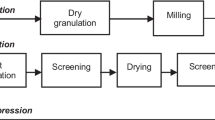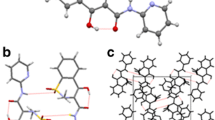ABSTRACT
Purpose
To explore the use of crystal inter-planar d-spacings and slip-plane interaction energies for predicting and characterising mechanical properties of crystalline solids.
Methods
Potential relationships were evaluated between mechanical properties and inter-planar d-spacing, inter-planar interaction energy, and dispersive surface energy as determined using inverse gas chromatography (IGC) for a set of pharmaceutical materials. Inter-planar interaction energies were determined by molecular modelling.
Results
General trends were observed between mechanical properties and the largest inter-planar d-spacing, inter-planar interaction energies, and IGC dispersive surface energy. A number of materials showed significant deviations from general trends. Weak correlations and outliers were rationalised.
Conclusions
Results suggest that the highest d-spacing of a material could serve as a first-order indicator for ranking mechanical behaviour of pharmaceutical powders, but with some reservation. Inter-planar interaction energy normalised for surface area shows only a weak link with mechanical properties and does not appear to capture essential physics of deformation. A novel framework linking mechanical properties of crystals to the distinct quantities, slip-plane energy barrier and inter-planar interaction (detachment) energy is proposed.
















Similar content being viewed by others
REFERENCES
Hancock BC, Clas SD, Christensen K. Micro-scale measurement of the mechanical properties of compressed pharmaceutical powders. 1: the elasticity and fracture behaviour of microcrystalline cellulose. Int J Pharm. 2000;209(1–2):27–35.
Jain S. Mechanical properties of powders for compaction and tableting: an overview. PSTT 1999;2(1):20–31.
Sanchez-Castillo FX, Anwar J, Heyes DM. Molecular dynamics simulations of granular compaction. Chem Mater. 2003;15:3417–30.
Feng Y, Grant DJW. Influence of crystal structure on the compaction properties of n-Alkyl 4-Hydroxybenzoate esters (Parabens). Pharm Res. 2006;23(7):1608–16.
Cottrell AH. The Mechanical Properties of Matter. London: Wiley; 1964. p. 121.
Morris KR, Griesser UJ, Eckhardt CJ, Stowell JG. Theoretical approach to physical transformations of active pharmaceutical ingredients during manufacturing processes. Adv Drug Dev Rev. 2001;48:95–114.
Sherwood JN. In: Sherwood Wiley JN, editor. The Plastically Crystalline State (Orientationally-disordered Crystals). Chichester, UK; 1979. p. 39.
Roberts RJ. The elasticity, ductility and fracture toughness of pharmaceutical powders. PhD Thesis, University of Bradford, UK. 1991.
Payne RS, Roberts RJ, Rowe RC, McPartlin M, Bashal A. The mechanical properties of two forms of primidone predicted from their crystal structures. Int J Pharm. 1996;145:165–73.
Roberts RJ, Rowe RC, York P. The relationship between indentation hardness of organic solids and their molecular structure. J Mater Sci. 1994;29:2289–96.
Day GM, Price SL, Leslie M. Elastic constant calculations for molecular organic crystals. Cryst Growth Design. 2001;1(1):13–27.
Sun CC, Kiang YH. On the identification of slip planes in organic crystals based on attachment energy calculation. J Pharm Sci. 2008;97(8):3456–61.
Docherty R, Clydesdale G, Roberts KJ, Bennema P. Application of Bravais-Friedel-Donnay-Harker, attachment energy and Ising models to predicting and understanding the morphology of molecular crystals. J Phys D Appl Phys. 1991;24:89–99.
Hartman P, Perdok WG. On the relations between structure and morphology of crystals. Acta Cryst. 1955;8(49):521.
Bennema P. On the crystallographic and statistical mechanical foundations of the forty-year old Hartman-Perdok theory. J Cryst Growth. 1996;166:17.
Beyer T, Day GM, Price SL. The prediction, morphology and mechanical properties of the polymorphs of paracetamol. J Am Chem Soc. 2001;123:5086–94.
Allen FH. The Cambridge Structural Database: a quarter of a million crystal structures and rising. Acta Cryst. 2002;B58:380–8. doi:10.1107/S0108768102003890.
Maple JR, Hwang MJ, Stockfisch TP, Dinur U, Waldman M, Ewig CS, et al. Derivation of class II force fields. I. Methodology and quantum force field for the alkyl functional group and alkane molecules. J Comput Chem. 1994;15(2):162–82.
Mayo SL, Olafson BD, William A, Goddard III. DREIDING: a generic force field for molecular simulations. J Phys Chem. 1990;94:8897–909.
Donnay JDH, Harker D. A new law of crystal morphology extending the law of Bravais. Amer. Mineralogist. 1937;22:463.
Wulff G. Zur Frage der Geschwindigkeit des Wachstums und der Auflösung der Krystallflächen. Zeitschrift für Krystallographie und Mineralogie. 1901;34:449–530.
Saxena A. A comparative study of the surface energetics of pharmaceutical excipients by inverse gas chromatography and molecular modelling. PhD Thesis, University of Bradford, UK. 2007.
Schultz J, Lavielle L. Interfacial properties of carbon fiber-epoxy matrix composites. In: Lloyds DR, Ward TC. ans Schreiber HP, editors. Inverse gas chromatography ACS Symposium Series 391, Washington, USA; 1989. p. 185–202.
Larsson I, Kristensen HG. Comminution of a brittle/ductile material in a micros ring mill. Powder Tech. 2000;107(1–2):175–8.
Rowe RC, Roberts RJ. The mechanical properties of powders. In: Ganderton D, Jones T, McGinity J, editors. Advances in pharmaceutical sciences, vol. 7. London: Academic Press Limited; 1995. p. 1–62.
Kendall K. The impossibility of comminuting small particles by compression. Nature. 1978;272:710–1.
Mackerell AD Jr. Empirical force fields for biological macromolecules: Overview and issues. J Comput Chem. 2004;25(13):1584–604.
Chatchawalsaisin J, Kendrick J, Tuble SC, Anwar J. An optimized force field for crystalline phases of resorcinol. CrystEngComm. 2008;10(4):437–45.
Tuble SC, Anwar J, Gale JD. An approach to developing a force field for molecular simulation of martensitic phase transitions between phases with subtle differences in energy and structure. J Am Chem Soc. 2004;126(1):396–405.
Neumann MA, Leusen FJJ, Kendrick J. A major advance in crystal structure prediction. Angew Chem Int Ed. 2008;47(13):2427–30.
Hartman P. The attachment energy as a habit controlling factor II. Application to anthracene, tin tetraiodide and orthorhombic sulphur. J Cryst Growth. 1980;49:157–65.
Anwar J, Tuble SC, Kendrick J. Concerted molecular displacements in a thermally-induced solid-state transformation in crystals of DL-norleucine. J Am Chem Soc. 2007;129(9):2542–7.
Author information
Authors and Affiliations
Corresponding author
Electronic supplementary material
Below is the link to the electronic supplementary material.
Supplementary Material S1
Experimental and optimised unit cell parameters for the materials examined using the CVFF (force field assigned charges) force field. Percentage deviations are shown in brackets. Deviations greater than 5% are shown in bold. (DOC 45 kb)
Supplementary Material S2
Experimental and optimised unit cell parameters for the materials examined using the Dreiding (Qeq charges) force field. Percentage deviations are shown in brackets. Deviations greater than 5% are shown in bold. (DOC 45 kb)
Supplementary Material S3
Experimental and optimised unit cell parameters for the materials examined using the Dreiding (Gasteiger charges) force field. Percentage deviations are shown in brackets. Deviations greater than 5% are shown in bold. (DOC 44 kb)
Rights and permissions
About this article
Cite this article
Shariare, M.H., Leusen, F.J.J., de Matas, M. et al. Prediction of the Mechanical Behaviour of Crystalline Solids. Pharm Res 29, 319–331 (2012). https://doi.org/10.1007/s11095-011-0543-1
Received:
Accepted:
Published:
Issue Date:
DOI: https://doi.org/10.1007/s11095-011-0543-1




